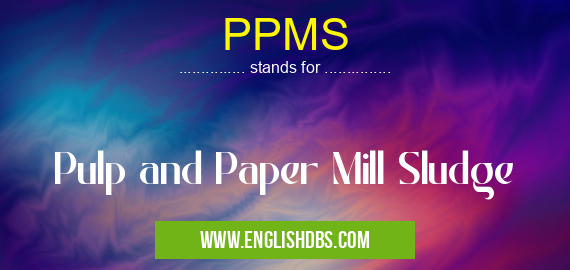What does PPMS mean in UNCLASSIFIED
PPMS stands for Pulp and Paper Mill Sludge. It is a waste product generated during the production of paper and paper products. PPMS is a complex mixture of organic and inorganic materials, including fibers, fillers, chemicals, and water.

PPMS meaning in Unclassified in Miscellaneous
PPMS mostly used in an acronym Unclassified in Category Miscellaneous that means Pulp and Paper Mill Sludge
Shorthand: PPMS,
Full Form: Pulp and Paper Mill Sludge
For more information of "Pulp and Paper Mill Sludge", see the section below.
Meaning of PPMS
PPMS is a common byproduct of the papermaking process. It is generated when the pulp is washed and dewatered. The sludge contains a variety of materials, including:
- Fibers: These are the main components of paper, and they are made up of cellulose, hemicellulose, and lignin.
- Fillers: These are added to the paper to improve its strength, brightness, and opacity. Common fillers include calcium carbonate, clay, and titanium dioxide.
- Chemicals: These are used in the papermaking process to bleach the pulp, control the pH, and improve the paper's properties.
- Water: This is the main component of PPMS, and it makes up about 95% of its weight.
Essential Questions and Answers on Pulp and Paper Mill Sludge in "MISCELLANEOUS»UNFILED"
What is Pulp and Paper Mill Sludge (PPMS)?
PPMS is a byproduct of the papermaking process that consists of wastewater solids, wood fibers, and various chemicals. It is a complex material that can vary in composition depending on the type of paper produced and the treatment processes used.
How is PPMS generated?
PPMS is generated during the various stages of papermaking, including pulping, bleaching, and wastewater treatment. It is removed from the wastewater stream through processes such as sedimentation, flotation, and filtration.
What are the environmental concerns associated with PPMS?
PPMS can pose environmental risks if not properly managed. It contains organic matter that can decompose and produce methane, a greenhouse gas. Additionally, it can contain heavy metals, dioxins, and other contaminants that can leach into soil and water.
How is PPMS typically managed?
PPMS management strategies vary depending on its composition and the available resources. Common methods include:
- Landfilling: PPMS can be disposed of in landfills, but it can take up valuable space and contribute to methane emissions.
- Incineration: PPMS can be burned to generate energy, but this can release pollutants into the atmosphere.
- Composting: PPMS can be composted with other organic materials to produce a soil amendment.
- Land application: PPMS can be applied to land as a fertilizer, but it must be carefully managed to avoid contamination.
Are there other emerging technologies for PPMS management?
Yes, researchers are exploring innovative technologies for PPMS management, such as:
- Anaerobic digestion: Breaking down PPMS in the absence of oxygen to produce biogas for energy generation.
- Thermal hydrolysis: Using heat and pressure to break down PPMS into smaller, more easily degradable molecules.
- Chemical extraction: Extracting valuable materials, such as cellulose, from PPMS for reuse.
Final Words: PPMS is a waste product that is generated during the production of paper and paper products. It is a complex mixture of organic and inorganic materials, including fibers, fillers, chemicals, and water. PPMS can be disposed of in a variety of ways, including landfilling, incineration, and composting.
PPMS also stands for: |
|
| All stands for PPMS |
